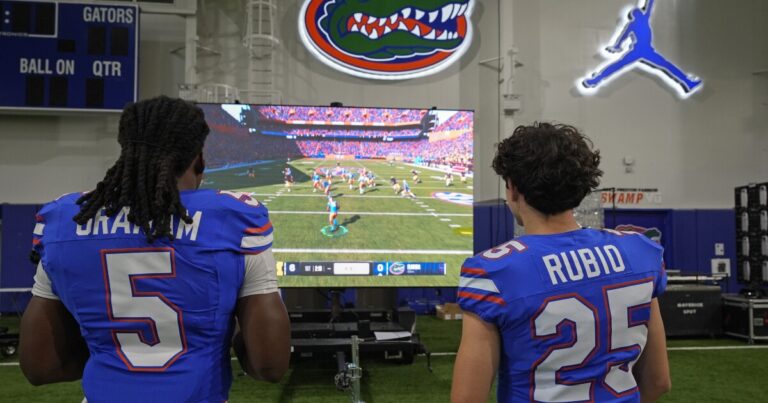Freshman quarterback DJ Lagway grabbed a controller, settled himself comfortably in a leather chair and immediately began tweaking Florida’s roster.
There was really only one thing to do: Lagway benched Graham Mertz and inserted himself into the starting lineup for a quick game of EA Sports College Football 25 against teammate Tank Hawkins.
From there, things started to get surreal.
With Lagway and Hawkins both playing for the Gators and substituting for Mertz, Lagway intercepted Hawkins’ first two passes.
“That was different,” Lagway joked.
It’s certainly a phenomenon that’s happening across the country as college football players finally get to play as themselves, or against themselves, in one of the hottest video games on the planet.
read more: Florida businesses could benefit from sweeping changes to college sports
EA Sports College Football 25 was released last week, and schools across the country have been hosting celebration parties, tournaments and fan events for their teams. Florida gave The Associated Press a behind-the-scenes look this week at teammates competing on the big screen during the team’s annual photo/video shoot.
There were cheers, groans and as much name-calling as you’d expect at a match between rivals.
“It’s like a childhood dream,” Lagway said of winning the matchup. “Growing up with this game, playing in the NCAAs, making my player, making my player on the game and now it’s automatically on there. It’s like a dream come true.”
Many of the current Gators grew up on the annual release of the NFL version of the game, Madden — after all, EA Sports’ last release of a college football game was in 2013. The popular game series had been dormant for 11 years, having been forced to cease production after growing calls for players to be compensated for their name, image and likeness rights.
Shortly after the NCAA’s decision to allow college athletes to profit from the brand, EA Sports decided to bring back the popular game, and in the days leading up to its release, 2.2 million gamers had already played during the early access period, with another 600,000 signing up for the EA Play trial.
EA Sports offered Football Bowl Subdivision players a minimum of $600 and a copy of College Football 25 to appear in the game, and thousands accepted, including everyone on Florida’s roster.
“It’s been like a dream come true for me as a kid. Growing up playing the game, playing in the NCAA, making players, making my players in the game and now it’s automatically there. It’s like a dream come true.” DJ Ragway
DJ Ragway
“I was watching the countdown,” said freshman linebacker Myles Graham, the son of former Florida State and NFL running back Ernest Graham. “Every day I was just counting down. I was looking forward to it. I was so excited. And then the day came and I’ve been obsessed with it ever since.”
Similar to Lagos’ roster adjustments, Graham quickly replaced teammate Shemar James at starting linebacker and then faced off against running back Anthony Rubio, the son of Florida Republican Sen. Marco Rubio.
“How bad would it be if I played Miami?” asked Rubio, a Miami native who chose Michigan over Florida to open the season.
As a kid, Rubio would spend hours playing old versions of EA Sports’ college football games, usually picking the Gators when playing against his childhood friends.
“Tim Tebow would beat them any day,” he said.
In fact, the left-hander was nearly unstoppable when he was ranked 15th in the NCAA Football Class of 2009. Lagway, Hawkins and Graham have a long way to go before they get to that point.
Lagway’s overall game rating of 80 is the highest of the group, not a bad start for a rising star rookie out of Texas who’s already appeared in a Gatorade commercial.
“I feel like I have to prove myself,” he said, adding that he hopes to jump up a few points when EA Sports updates its ratings later in the season. “That’s something to keep an eye on. I’m excited. It’s going to be fun.”
Lagway and his teammates praised some of the game’s more realistic aspects, such as the projection, the ability to dodge tackles, and the crowd cheering effects. They also liked that the creators incorporated NIL trades and the transfer portal into the dynasty mode, in which gamers can develop any program into a five-star powerhouse.
But most of all, it was cool to see ourselves in a video game.
“It’s kind of like manifesting what you want to do in a way,” Hawkins says. “What you do in video games, you could probably, definitely, do in real life.”
Running back Montrell Johnson, one of Florida’s best players and widely regarded as the team’s top gamer, stayed up late playing College Football 25 before heading to the Southeastern Conference preseason media day event in Dallas, saw the game being played in the Green Room and jumped at the chance to play some more.
Defensive lineman Caleb Banks spent $150 to purchase the MVP bundle package, which gave him early access to the game.
“I couldn’t wait another day,” he says. “I just couldn’t. But it was worth the wait. If I could do it again, I would.”
His mother wants an autographed copy of the game, but there’s one problem: “They’re sold out everywhere,” he says.
There are plenty of copies in Florida’s locker room, all in play. Lagway can’t remember how many times he’s played the game, but it will surely be less when training camp starts next week. He does know how many passes he’s had Mertz throw.
“One,” he said with a laugh, “I did a trick play and he threw it to me.”
Copyright 2024 WUSF Public Media – WUSF 89.7

